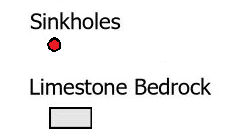Limestone bedrock is fairly common throughout Pennsylvania and is one of the leading causes of sinkholes. Interact with the map below using your mouse to move around the map and to click on sinkholes and limestone bedrock deposits to learn more details.

Limestone Bedrock Formations
Lithology (Layering) and Composition
Rock layers in our Earth's crust can tell geologists a lot about what the Earth's surface was like millions of years ago. Importantly, limestone bedrock tells geologists that at the time of formation, that area was a shallow sea. Limestone formed in these environments because its main composition is calcium carbonate, which was deposited when shells and pieces of shells from small shallow water invertebrates settled down to the sea floor. Over time these calcium carbonate shell fragments lithified into a solid rock, which can be limestone or dolomite.
For lithology, all formations included in the map include limestone as either the primary or secondary rock type. Other than the limestone, dolomite is another major rock type that is found in these formations. Dolomite is very similar in composition to limestone; the main difference between the two is that dolomite contains magnesium and limestone does not. Other rock types that are found with limestone in these formations include shale, black shale, chert, marble, siltstone, and phyllite.
The Limestone's Geological Age
The table below shows the geological period of each bedrock formation that contains limestone, the abbreviation for that formation and the period's age range. When clicking on an area of bedrock in the map above, one of the pieces of information you will get is that geological formation's abbreviation. Each abbreviation can be found in the table; use that abbreviation to discover the period in Earth's history when it was formed.
The age of the formation indicates the time period in the geologic record in which the sediments that later became that layer of bedrock were deposited. All of the layers that are depicted in the map were deposited in the Paleozoic era (541 - 251.9 million years ago), with the Cambrian period (starting 541 mya) being the oldest, and the Pennsylvanian (ending 298.9 mya) being the youngest. A few of the formations were formed during transitions between periods and are shown as having multiple time periods.
The abbreviations in the table consist of two parts, one or two capital letters followed by another one to three lower-case letters. The capital letters represent the period in which the layers were formed. In this case, C = Cambrian; O = Ordovician; S = Silurian; D = Devonian; P = Pennsylvanian. The transition periods are denoted with two capital letters in the abbreviation. The lower-case letters represent the name of the specific bedrock formation, which is not spelled out here.
| Period of Formation | Formation Abbreviations | Age of Formation (MYA)* |
|---|---|---|
| Cambrian | Cal, Cbs, Ce, Cg, Ck, Cm, Cms, Cph, Cr, Csb, Csc, Csg, Cul, Cw, Cz | 541.0 - 485.4 |
| Cambrian thru Ordovician | OCc | 541.0 - 443.8 |
| Ordovician | Oa, Oan, Ob, Oba, Obl, Obv, Oc, Ocl, Ocn, Oe, Oha, Ohl, Ohm, Ojk, Oml, Ons, Oo, Ops, Orr, Os, Osl, Osp | 485.4 - 443.8 |
| Silurian | Sdp | 443.8 - 419.2 |
| Silurian thru Devonian | DSkc, DSkm, DSkt | 443.8 - 358.9 |
| Devonian | Dbe, Dm, Don, Dosn | 419.2 - 358.9 |
| Pennsylvanian | Pm | 323.2 - 298.9 |
* MYA = Million Years Ago
Limestone Uses
Limestone bedrock is fairly common throughout southeastern, central, and southwestern Pennsylvania. It is a very important resource both geologically and economically. Limestone mining is a big industry in Pennsylvania. Limestone has a variety of uses from aggregate in concrete and pavement to riprap and railroad ballast. These, and numerous other uses make it a very versatile resource and a profitable industry.
Sinkholes
Formation and Location
Sinkholes are holes that develop in the bedrock below ground level when slightly acidic rain water dissolves the limestone to create voids; when the bedrock above the void can no longer support the soil above, it collapses into the void, creating a hole on the surface. They can be very unpredictable and happen out of nowhere. Sinkholes can range in sizes from small, foot sized holes, to large ones that are big enough to swallow up cars and endanger houses. As you can see in the table below, as of May 2020 there have been over 3,600 sinkholes in Pennsylvania. Roughly 75% of those were located in areas that have mainly limestone bedrock. On the map above, each recorded sinkhole is marked as a small red dot. If you zoom way in, you may be able to see that many are located very close together.
| # of Sinkholes | |
|---|---|
| Sinkholes Within Limestone Geology | 2,706 |
| Total Sinkholes | 3,619 |
The map also shows that the majority of those that are not located on bedrock that is mainly limestone are still near the limestone areas. This strong correlation to limestone bedrock also coincides with being located in more developed areas. This is due to an imbalance in underground pressures as a result of construction: removing and adding soil and rock during construction, the lasting presence of the built structures, and pumping groundwater for water supplies. Construction can throw off a delicate balance between underground water pressures and the weight of the ground above it, causing the ground to sink and exacerbating limestone erosion.